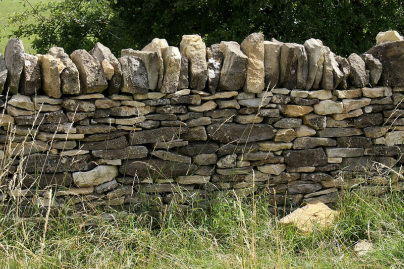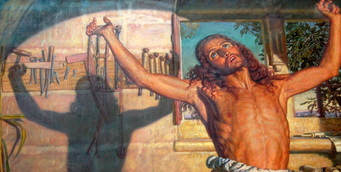Disciplecraft
I was brought up in the area of the UK known as the Cotswolds. Here the fields have often been given their shape and size by walls made from the local Cotswold sandstone. Many of these walls are hundreds of years old. As a youngster I was deeply impressed by the work of the Dry-Stone Wallers creating such mortar-less walls. With only the simplest of tools – a chipping hammer, a string line, and perhaps a shovel – the dry-stone waller builds a strong boundary wall of elegance and durability that will serve its purpose for many generations. On completion there is nothing remaining behind the waller as debris and chippings will have been incorporated into the centre of the wall. There is simply no mess and nothing ‘left-over.’ The strength, resilience and serviceability of the wall are achieved by the artful skill of the waller. This is a skill learnt over time and with much practice; its application produces something of beauty that will remain long after the individual who created it. Such walling is an example of first order craft that turns simple stones into purposeful artifacts.
Suppose we thought of discipleship as first and foremost a craft to learn and practice ...
Disciplecraft
Skills in following Christ - learnt, practiced, and applied so that discipleship becomes a craft in which nothing is wasted. Think of discipleship as a skill that needs to be kept up - like many skills, use it or lose it! Think of discipleship as a language that needs to be used in order keep it lively and useable. Memory is an essential component of discipleship.
Disciplecraft and memory
Our memories work by association. We remember most easily things that are pertinent to our present circumstance. Prompted by whatever current concern or need it is, our memories re-assemble memories that serve those concerns and needs. In this sense memory is 'presentist,' it serves the purposes of the present. In other words memory is something a person does rather being just something that is retained and recalled (the use of the term 'memory' associated with computers reinforces an unhelpful idea that our memories are just massive accumulations). Prompted by what is happening now and our interactions with other people we assemble memories that support and enhance our knowledge and our actions. For example, on meeting an old school friend that you haven't seen for years, the conversation between you will prompt memories that fuel and enhance that conversation. The encounter enables memories. Our brains do this with incredible speed and only occasionally are we aware of struggling to bring the needed memory to consciousness.
In discipleship we need other disciples to keep our discipleship memories alive and purposeful. Sharing memories - in symbols, understandings, stories, and images - keeps those memories fresh and serviceable. One of the major issues in our contemporary efforts to live a life of discipleship is that many of the things that reminded our forebears in the faith are no longer available to us. To put it simply, much of our Christian collective memory has been forgotten. Memories of Christian understandings and interpretations - expressed in all kinds of ways - have become ever more attenuated. We need each other to practice the skills and craft of discipleship so that those things become second-nature to us, like learning, and never forgetting, how to ride a bike.
Using art to understand the process
Look at this picture:
http://www.lukasweb.be/nl/foto/de-thuiskomst-van-de-verloren-zoon
painted by Edouard De Jans (1885-1919) and completed in 1878. Without reading the title, are you clear about the story it is telling? Many people are mystified by what it is saying. If you are familiar with the story in Luke's Gospel (15.11-32) the picture becomes easy to interpret. For example, the faces now tell you a lot - the shame of the young man who is crouching, the anguish of the older man, the anger of the one coming up the hill, the interest of the onlookers, etc. Motivations, understandings, interpretations, and dispositions all become areas of potential disclosure and deepening awareness. Without the memory of the biblical story the picture becomes all but impossible to interpret. The craft is seeing what the artist has done with the story from the Bible and using our Christian understanding to 'see' what we can make of it (or is it, to see what God can tell us through the memory, language and symbols he has given us?)
This idea of the skill and craft of discipleship is expressed in the picture The Shadow of Death, completed by William Holman Hunt whilst in Jerusalem in 1873, see it here:
http://www.leedsartgallery.co.uk/gallery/listings/l0034.php
Suppose we thought of discipleship as first and foremost a craft to learn and practice ...
Disciplecraft
Skills in following Christ - learnt, practiced, and applied so that discipleship becomes a craft in which nothing is wasted. Think of discipleship as a skill that needs to be kept up - like many skills, use it or lose it! Think of discipleship as a language that needs to be used in order keep it lively and useable. Memory is an essential component of discipleship.
Disciplecraft and memory
Our memories work by association. We remember most easily things that are pertinent to our present circumstance. Prompted by whatever current concern or need it is, our memories re-assemble memories that serve those concerns and needs. In this sense memory is 'presentist,' it serves the purposes of the present. In other words memory is something a person does rather being just something that is retained and recalled (the use of the term 'memory' associated with computers reinforces an unhelpful idea that our memories are just massive accumulations). Prompted by what is happening now and our interactions with other people we assemble memories that support and enhance our knowledge and our actions. For example, on meeting an old school friend that you haven't seen for years, the conversation between you will prompt memories that fuel and enhance that conversation. The encounter enables memories. Our brains do this with incredible speed and only occasionally are we aware of struggling to bring the needed memory to consciousness.
In discipleship we need other disciples to keep our discipleship memories alive and purposeful. Sharing memories - in symbols, understandings, stories, and images - keeps those memories fresh and serviceable. One of the major issues in our contemporary efforts to live a life of discipleship is that many of the things that reminded our forebears in the faith are no longer available to us. To put it simply, much of our Christian collective memory has been forgotten. Memories of Christian understandings and interpretations - expressed in all kinds of ways - have become ever more attenuated. We need each other to practice the skills and craft of discipleship so that those things become second-nature to us, like learning, and never forgetting, how to ride a bike.
Using art to understand the process
Look at this picture:
http://www.lukasweb.be/nl/foto/de-thuiskomst-van-de-verloren-zoon
painted by Edouard De Jans (1885-1919) and completed in 1878. Without reading the title, are you clear about the story it is telling? Many people are mystified by what it is saying. If you are familiar with the story in Luke's Gospel (15.11-32) the picture becomes easy to interpret. For example, the faces now tell you a lot - the shame of the young man who is crouching, the anguish of the older man, the anger of the one coming up the hill, the interest of the onlookers, etc. Motivations, understandings, interpretations, and dispositions all become areas of potential disclosure and deepening awareness. Without the memory of the biblical story the picture becomes all but impossible to interpret. The craft is seeing what the artist has done with the story from the Bible and using our Christian understanding to 'see' what we can make of it (or is it, to see what God can tell us through the memory, language and symbols he has given us?)
This idea of the skill and craft of discipleship is expressed in the picture The Shadow of Death, completed by William Holman Hunt whilst in Jerusalem in 1873, see it here:
http://www.leedsartgallery.co.uk/gallery/listings/l0034.php
Christ the artisan carpenter is stretching after labouring in the workshop - the tools and wood shavings of that work are all around. There is plenty of evidence of craft and skill. As he stretches the sun casts a shadow which is the cross prefigured. The gifts of the magi that his mother is examining in the chest on the floor begin to make sense. The skill being portrayed is that of seeing the cross foretold in the labours of Christ. The artist asks his viewers if they too can use the tools of faith to see the costliness and graciousness of Christ's work among us.
Do we have the skill and the craft to read God into and out of our experiences? Can we help each other develop those things so that biblical signs, symbols and stories become out tools for recognizing God among us?
Try out your Disciplecraft skills
Here's something to test that skill. It's a picture called Among the Missing - Scene in a Cornish Fishing Village, completed in 1884 by Walter Langley (1852-1922). The webpage to look for is that of Penlee House Gallery and Museum, Penzance, (as in thumbnail below) click:
http://www.penleehouse.org.uk/artists/walter-langley.html
What motifs, symbols, or stories might help you understand the picture and the emotions of the people it details? What biblical stories might help your understanding? Unlike the pictures above this isn't an overtly religious picture, but it is a powerful portrayal of human experience that asks people of faith to have the skill to find a language to help in terrible circumstances. The artist has done that through his painting; can we do something similar with words of faith prompted by his work? That's the craft of discipleship.
Do we have the skill and the craft to read God into and out of our experiences? Can we help each other develop those things so that biblical signs, symbols and stories become out tools for recognizing God among us?
Try out your Disciplecraft skills
Here's something to test that skill. It's a picture called Among the Missing - Scene in a Cornish Fishing Village, completed in 1884 by Walter Langley (1852-1922). The webpage to look for is that of Penlee House Gallery and Museum, Penzance, (as in thumbnail below) click:
http://www.penleehouse.org.uk/artists/walter-langley.html
What motifs, symbols, or stories might help you understand the picture and the emotions of the people it details? What biblical stories might help your understanding? Unlike the pictures above this isn't an overtly religious picture, but it is a powerful portrayal of human experience that asks people of faith to have the skill to find a language to help in terrible circumstances. The artist has done that through his painting; can we do something similar with words of faith prompted by his work? That's the craft of discipleship.



